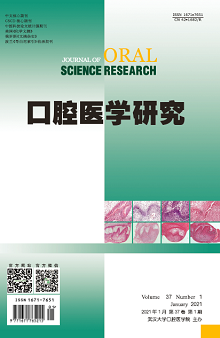|
|
Effects of Phillyrin on p38 MAPK/c-Fos Signal Pathway and Osteoclast Activation in Periodontitis Rats
SU Juanjuan, ZHU Yongcui, ZHANG Wenling
2021, 37(1):
33-38.
DOI: 10.13701/j.cnki.kqyxyj.2021.01.008
Objective: To investigate the effects of phillyrin on p38 MAPK/c-Fos signal pathway and osteoclast activation in periodontitis rats. Methods: The periodontitis rat model were established and randomly divided into groups: model group, low dose phillyrin group, middle dose phillyrin group, high dose phillyrin group, and vitamin C group, with 12 in each group, and another 12 rats were set as control group. After treatment, methylene blue staining was used to detect alveolar bone resorption (distance from the border of enamel cementum to the crest of alveolar ridge). HE staining was used to detect the periodontal pathological morphology. The number of osteoclasts in periodontal tissue was detected by TRAP staining. The levels of serum tumor necrosis factor-α (TNF-α) and interleukin-6 (IL-6) were detected by enzyme-linked immunosorbent assay (ELISA). The expression of p38 MAPK/c-Fos pathway related proteins was detected by Western blot. Results: Compared with the control group, the periodontal tissue of the model group showed epithelial defect, rupture, abnormal morphology, disordered arrangement of periodontal membrane fibers, inflammatory cell infiltration, and other pathological damage, and the distance from the border of enamel cementum to the crest of alveolar ridge, the number of osteoclasts, the levels of TNF-α and IL-6, and the expressions of p38 MAPK/c-Fos pathway related proteins c-Fos and p-p38 MAPK/p38 MAPK in periodontal tissues were significantly higher (P<0.05). Compared with the model group, the pathological damage of periodontal tissue in the low, middle, and high dose phillyrin groups and vitamin C group was alleviated, the distance from the border of enamel cementum to the crest of alveolar ridge, the number of osteoclasts, the levels of TNF-α and IL-6, the expression of c-Fos protein and p-p38 MAPK/p38 MAPK in periodontal tissues were significantly lower (P<0.05), and phillyrin groups were dose-dependent (P<0.05), while there was no significant difference between high dose phillyrin group and vitamin C group (P>0.05). Conclusion: Phillyrin can down-regulate p38 MAPK/c-Fos signal pathway, inhibit periodontitis and osteoclast activation, reduce periodontal tissue damage, and improve periodontitis symptoms in rats.
References |
Related Articles |
Metrics
|

